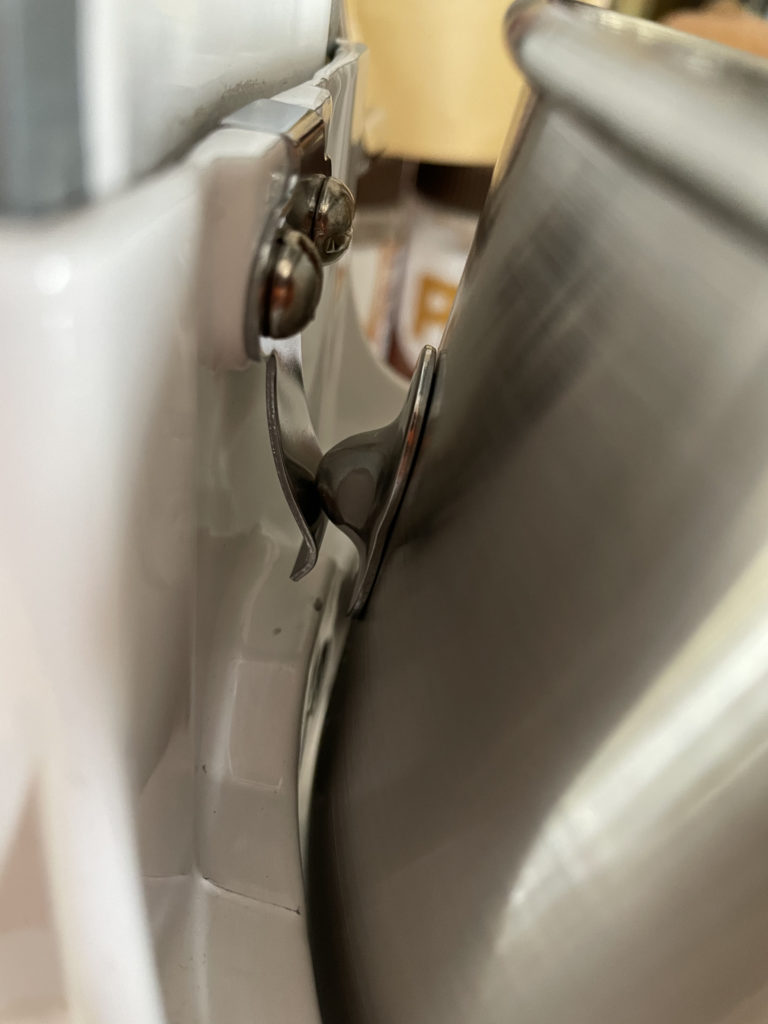Here are some tips to help keep your bowl-lift KitchenAid mixer in dependable working order.
Keep it Clean
After each use, unplug the mixer. Then clean it thoroughly using only a soft damp (not wet) cloth and very light pressure. If there’s anything sticky that won’t wipe off easily, you can use a little dish soap on a damp sponge, but take care to keep water out of the mixer, especially around the lever slots. Clean everywhere, including the back of the mixer around the power cord. Pay special attention to the underside of the “head”, the planetary, and the beater shaft. You can use a microfiber cloth or a soft dish towel to dry everything off and keep it shiny.
Every few uses, carefully flip the machine over (use a soft towel to protect the head) and wipe the underside of the base clean (again with a damp cloth). This keeps dust, flour, etc from accumulating there, which attracts moisture that in turn cause rust and corrosion.
While the machine is upside down, inspect the feet and wipe off any accumulated crud. If the feet are dry, cracked, or hard, replace them. (They pull off, and you can get replacements directly from KitchenAid or on Amazon.) This will make the mixer less likely to “walk” around the counter (or off the edge).
Routine Maintenance
If you have a Professional 6000HD, Pro Line, Commercial, or any of the bowl-lift models introduced in 2023 or later, disregard the rest of this section. Those models use an integrated motor/drivetrain assembly which is considered maintenance-free, and there are no maintenance or repair parts or procedures. Once every few years you can remove the planetary, clean any buildup off the ring and pinion gears, and apply a small amount of food-safe grease.
Otherwise, if you use the machine more than once a week, and/or use it for heavy loads such as bread dough or for extended high-speed operation, or if you make if you use the mixer to make money, I recommend that you have the gears cleaned, regreased, and checked annually. This will keep the moving parts in good operating condition, and will give you a chance to catch any problems before they get really bad (and expensive to fix).
For typical light-to-moderate household use, I recommend that you do this every three to five years. You can find a list of parts and materials for the job here (depending on model type):
K5-A, K5SS, KSM5, KSM50, and other K5-type models which use a round rear cover with a screw on top: K45/K5 Clean and Re-grease Parts
KG25, KM25, KV25, KD26, KL26, KP26, and other “Professional” branded models: “Pro” Series Clean and Re-grease parts
No matter what schedule you follow, if at any time you see oil leaking down the beater shaft, or out around the trim band, it’s time to service the machine.
Store the Accessories Separately
It may be tempting to leave a frequently used accessory on the beater shaft even when the mixer isn’t in use. If you do this, the standard accessories (flat beater, dough hook, or wire whisk) will get galvanically welded to the beater shaft and you’ll have an extremely difficult time removing them. (This won’t happen with the stainless accessories, but it is still possible for rust to form on the beater shaft and create problems. So if you have stainless accessories, store them separately as well.)
You can store the accessories in the mixer bowl, or in any convenient location that isn’t the beater shaft.
Keep the Spring Springy
When you’re not using the mixer, let the bowl rest gently on the bowl spring — don’t snap it in. (You can also store the bowl separately from the mixer, if you have the space.)

This lets the spring stay relaxed when not in use, which in turn maintains its shape and helps it grip better.
Are you finding that the bowl pops out of the lift, especially when you’re making a heavy dough? First, check the screw(s) and make sure that they’re tight. (The Pro series uses a single screw, and older model types use two.) If the screws are tight but the bowl is still popping out under load, it’s probably time to replace the spring.
The KitchenAid part number for K5-type mixers is WP3182857 and it costs about US$5. (Note: if you have a Hobart-era K5SS, this part will not fit. You could modify it by grinding off the top above the screw holes.)
For the Pro Line, the part number is WPW10504114 and the cost is about the same.
Take care of your mixer, it’ll take care of you.
These machines last so long that we often get attached to them; and for many folks they become treasured family heirlooms. Regular care and maintenance is the key to a long and happy mixer life.